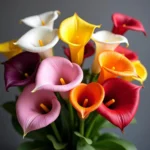Huckleberry, a small, round fruit often found in the wild, holds a captivating allure. Its deep, complex color, often mistaken for blue or purple, is a spectacle in itself. But what color is huckleberry exactly?
The truth is, huckleberry’s color defies easy categorization. It resides in a fascinating spectrum between blue and purple, tinged with subtle red undertones. This unique hue results from a combination of natural pigments, primarily anthocyanins, which vary in concentration depending on the huckleberry variety and environmental factors.
Delving Deeper: Factors Influencing Huckleberry Color
Just like a fine wine, the color of a huckleberry isn’t static. Several factors contribute to its depth and richness:
- Variety: Different huckleberry species, from the common black huckleberry to the red huckleberry, inherently possess varying color profiles.
- Ripeness: As huckleberries ripen, their color deepens. Younger berries often exhibit lighter shades, while mature ones boast rich, dark hues.
- Growing Conditions: Sunlight, soil composition, and even altitude can influence the concentration of pigments in huckleberries, subtly altering their color.
Describing Huckleberry Color: Beyond Simple Labels
While “bluish-purple” provides a general idea, capturing the essence of huckleberry color demands a more nuanced vocabulary:
- Deep Indigo: This term aptly describes the depth and intensity of the color, hinting at its complexity beyond simple blue or purple.
- Blackish-Purple: This conveys the near-black appearance of some huckleberry varieties, particularly when ripe.
- Aubergine: This term, borrowed from the French word for eggplant, accurately reflects the deep, purplish-brown hue often seen in huckleberries.
Huckleberry in Design: Embracing Nature’s Palette
The unique color of huckleberries has inspired its use in various design fields:
- Fashion: From scarves and dresses to handbags and jewelry, huckleberry provides a sophisticated and versatile color choice.
- Interior Design: Huckleberry-toned walls create a warm, inviting ambiance, while accents like throw pillows or rugs add pops of rich color.
- Graphic Design: Huckleberry offers a distinctive hue for logos, branding elements, and website designs, conveying a sense of natural elegance.
FAQ: Unraveling Huckleberry Color Mysteries
1. Are all huckleberries the same color?
No, huckleberry color varies by species, ripeness, and growing conditions. While the dominant hue lies between blue and purple, variations exist, ranging from lighter shades to nearly black.
2. Why are huckleberries often mistaken for blueberries?
Both berries share a similar size and dark coloration. However, huckleberries possess subtle red undertones and often have a less uniform color distribution than blueberries.
3. What colors complement huckleberry in design?
Huckleberry pairs well with a range of colors, including cream, beige, gray, and light wood tones for a balanced and sophisticated aesthetic.
Conclusion: Celebrating the Allure of Huckleberry Color
Huckleberry color is a testament to nature’s artistry, a captivating blend of blue, purple, and red undertones that defies simple labels. Whether found in the wild or inspiring design choices, huckleberry’s unique hue continues to fascinate and inspire.
Need help incorporating huckleberry hues into your next project? Contact us at 0373298888, email us at [email protected], or visit our showroom at 86 Cầu Giấy, Hà Nội. Our team is available 24/7 to provide expert advice and assistance.
